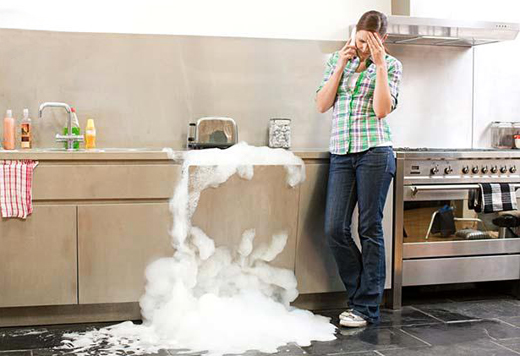
One of the greatest comforts of modern kitchens is the ability to put your dirty dishes in a box and have them magically come out clean. Dishwashers have made it simple to keep your dishes and kitchen clean without having to spend a lot of time hand-washing each item. However, dishwashers can sometimes make things too easy for us, and we can make mistakes while using them. These mistakes can cost homeowners in many ways, from simply using more energy or water than necessary, to breaking the dishwasher, or even causing water damage or other large damages to your home. That's why Warner Service has put together these 10 dishwashing tips to keep your kitchen running smoothly and safely, just in time for the holidays!
1. Dishwasher Detergent – In addition to choosing the right detergent for your needs, it is also important to follow the directions on the box. Don’t think that adding extra detergent to the dishwasher will get the dishes extra clean. In reality it can leave a film of detergent on the entire contents of the dishwasher that you'll taste later, or worse, it might bubble up and overflow! Use the right detergent and use it the right way.
2. Overfilling – It’s great to maximize space when we fill the dishwasher, but too often we overcrowd our dishes. This not only prevents dishes from getting clean, but this can also damage them as they bump into one another. Space the dishes so that each one has the space it needs to get clean.
3. Too Much Food – Today’s dishwashers are amazing at removing food residue without the need to prewash our dishes, but even the most advanced dishwasher can develop trouble when too much food is left on dishes. While we may not need to prewash our dishes, scraping them is a necessity to keep the dishwasher running smoothly.
4. Non-Dishwasher Safe Items – Even though we might wish that a dishwasher could clean everything, some items just aren't safe to use.Avoid putting wood, copper, cast-iron, delicate glassware and other non-dishwasher safe items in the dishwasher. Wood splits and cracks when exposed to dishwasher temperatures, humidity and water. Delicate glassware can break in a dishwasher, making for a big mess to clean up. Some metals like cast-iron and copper are not meant to be washed in the dishwasher and can become damaged as well as cause damage to other dishes.
5. Top Rack vs. Bottom Rack – It does matter where dishes are placed in the dishwasher. There are a lot of items that are dishwasher-safe only when placed on the top rack. To get thoroughly clean, many other dishes need to be on the bottom rack. Put glasses, bowls, cups, and oversized serving utensils on the top. Plates, pots, pans, and utensils should be on the bottom. Some items can melt, warp, or break if they are put in the wrong places.
6. Blocking the Sprayer – It’s a good idea to know how the sprayer in your dishwasher works. For best results, you want the sprayer to be able to reach every corner of the dishwasher, and clean every dish. If there is a large bowl or pan that blocks the path of the sprayer, the end of a cycle will reveal dirty dishes. Double-check that your sprayer has full range of motion and isn’t being blocked.
7. Over-Packing Utensils – The little tines of forks are notorious for holding onto residue in the dishwasher. Spoons that nest together during a cycle can also remain encrusted with food. You should alternate utensils pointing up and down to prevent this nesting effect and always point knives downward for safety reasons.
8. Partially Filled – While a partially filled dishwasher may seem like a better idea than an overloaded one, it’s a waste of resources. Instead of using twice as much water and detergent over a couple of loads, wait to wash your dishes until you have a full load, or hand wash small loads. Partially full loads also allow dishes to bang and bump into each other and increase the risk of breaking.
9. Unloading – Be sure to unload the bottom rack of the dishwasher first. The tops of cups and bowls on the top rack can sometimes pool water during a cycle. If you move them first, you’ll dump and splash water onto the clean dishes below. Wait and unload the top rack last.
10. Running the Garbage Disposal After the Dishwasher – The dishwasher drains into the same pipe as your sink, so the drain must be clear. Running your garbage disposal before starting the dishwasher clears the pipes and drains.
And that's it; you're ready for a smooth post-Thanksgiving clean-up! If you need any help preparing your plumbing or HVAC system before this year's holidays, contact Warner Service to have a qualified technician examine your home and get you on the right track. To subscribe for more helpful articles, click the button below!


